Imagination Announces PowerVR Series7 GPUs - Series7XT & Series7XE
by Ryan Smith on November 10, 2014 8:50 AM EST- Posted in
- GPUs
- Mobile
- Imagination Technologies
- PowerVR
- PowerVR Series7
Series7XT In Detail
Now that we’ve had a chance to look at the common Series7 architecture, let’s take a look at the features and properties of Series7XT in particular.
Series7XT will be offered with 2 optional feature additions. The first is the aforementioned FP64 ALU, which is being offered as part of what Imagination is calling the HPC Feature Pack. As FP64 operations are not necessary for graphics work (and often even FP16 will do), the FP64 functionality is being offered to customers who want to build HPC hardware out of Series7XT. PowerVR hardware has up until now not been a competitor in the HPC space, so this marks a significant turning point for Imagination and would have them challenging frontrunner NVIDIA in this space. Also of note here, as the base 7XT configuration only supports OpenCL 1.2 Embedded Profile, the HPC pack upgrades 7XT’s OpenCL capabilities to 1.2 Full Profile.
Meanwhile the other optional feature pack for Series7XT is the Direct3D 11 pack, which is primarily geared towards customers who would be building Windows Phone and Windows RT devices. Imagination made Direct3D 11 an optional feature on 6XT, and is doing the same on 7XT. In the case of 6XT the D3D option would have added the necessary tessellation capabilities that are now default on 7XT, so for 7XT this is likely more about D3D features such as S3TC that require additional licensing.
Moving on, for as much as Imagination’s various enhancements ultimately improve performance, really it’s power efficiency that’s driving most of Imagination’s performance gains, and 7XT in turn is designed to further improve on Imagination’s power efficiency. Unfortunately Imagination isn’t throwing out any numbers here – just that 7XT can offer similar performance as 6XT for less power – but on the subject of power efficiency they have documented their efforts to deal with throttling.
To be clear here this is a matter ultimately in the hands of SoC integrators and is not something Imagination can directly control, but as a supplier they can offer advice and suggestions to their customers to improve the experience. Short of making PowerVR GPUs low power in the first place (and this is something everyone in this space tries to do), the next best thing they can do is to encourage customers to be mindful of throttling and to discourage designing their clockspeed governors to be bursty. While the “hurry up and go to sleep” motto makes a lot of sense for CPUs, it makes less sense for GPUs due to the fact that most workloads are sustained. By providing good real-time power usage data to the OS and by discouraging high maximum clockspeeds that lead to burst-and-throttle behavior from governors, for Series7 Imagination is at least trying to ensure that throttling is minimized.
Finally, Imagination has outlined the different configurations that Series7XT will be available in. Starting in 2 cluster configurations, 7XT scales up to 16 cluster configurations, or twice as large as 6XT. 2-4 cluster configurations are expected to be used in phones and TVs, meanwhile 6-8 cluster configurations are expected to be used in tablets, automotive, and ultrabooks. Finally the 16 cluster configuration would be targeted at non-traditional spaces for PowerVR products, such as full notebooks, dedicated (set-top) gaming devices, and servers. With a hefty 512 FP32 ALUs Imagination expects that the 16 cluster configuration should rival lower-end discrete GPUs, which would certainly be the competition for the device categories that Imagination is chasing.
Series7XE In Detail
Moving on, at the other end of the spectrum we have the Series7XE GPUs. These products are the successors to the Series6XE GPUs, and like their predecessors are focused on a narrower feature set for low cost devices, with an emphasis on area efficiency over power efficiency.
Of the Series7 features we’ve covered so far, Series7XE gains access to virtually all of those features. However a larger number of those features are optional and are not in the base configuration. Of note, all of the general enhancements for the frontends and the USC are carried over for the base configuration. However the tessellation block (and hence AEP support) is optional.
As a result 7XE has 4 optional feature packs to build on top of its base OpenGL ES 3.1 functionality. The AEP adds the tessellator and other AEP-centric functionality from 7XT that isn’t in 7XE’s default configuration. Meanwhile the Compression Pack segregates certain compression features from 7XE so that they’re only included in designs that need them (since SoC manufacturers may want to use 3rd party compression technology). HEVC and 10-bit YUV support is also optional for 7XE, and finally the virtualization features we discussed earlier are optional as well.
Since 7XT is targeted at 2 cluster and above configurations, 7XE is designed to cover the 1 and ½ cluster configurations. This results in 2 configurations, the GE7800 which implements a full cluster, and the GE7400 which implements a half-cluster. With the 1 cluster configuration targeted at low-end phones and TVs, the half-cluster configuration will be in the cheapest and simplest devices, along with being a candidate for high-end wearable devices.
Imagination says that at the low clockspeeds they’re envisioning for 7XE wearables, the full load power for the GPU would be under 1W, with low/idle power consumption of course being much lower yet. Any kind of power consumption approaching 1W definitely also approaches a “high-end” niche for wearables, but none the less it is viable if for any reason someone needed to build a wearable device that could handle OpenGL ES 3.1 graphics.


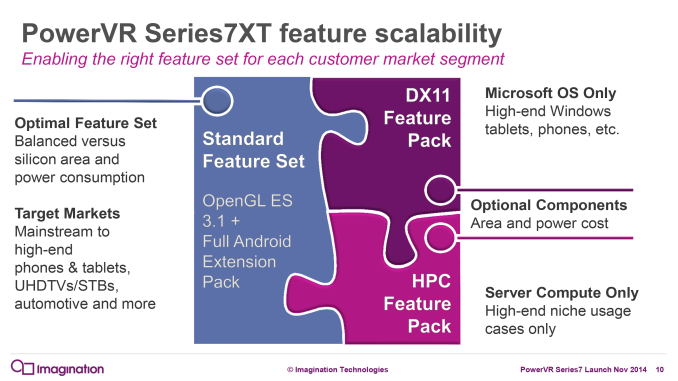
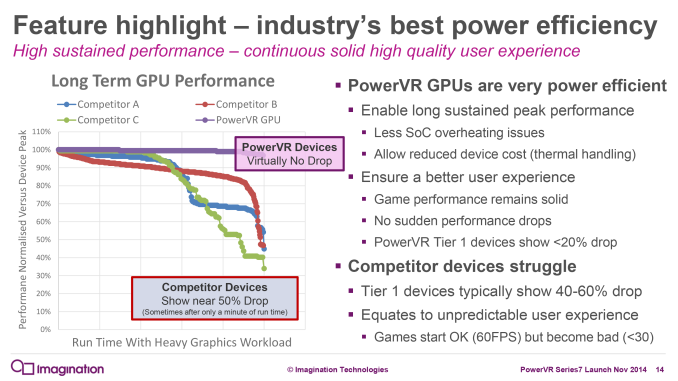
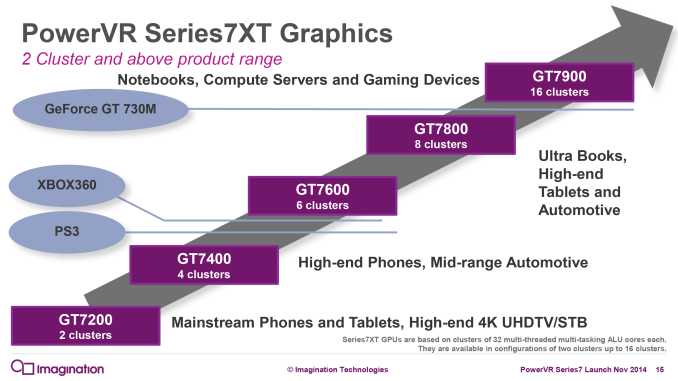
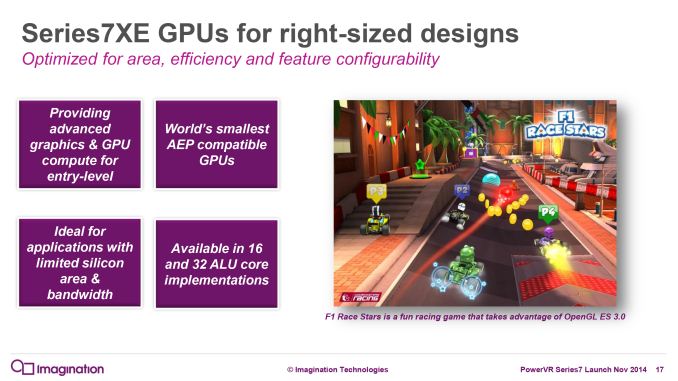
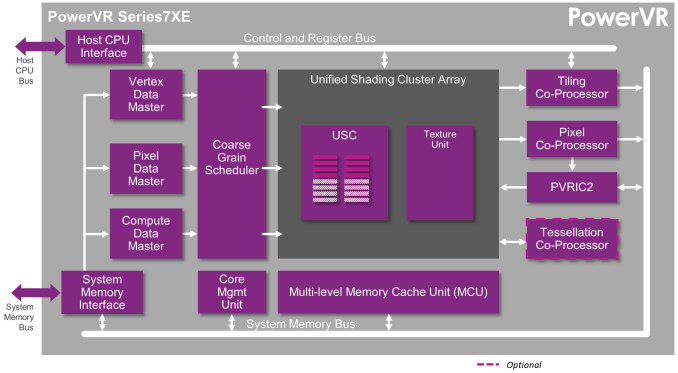
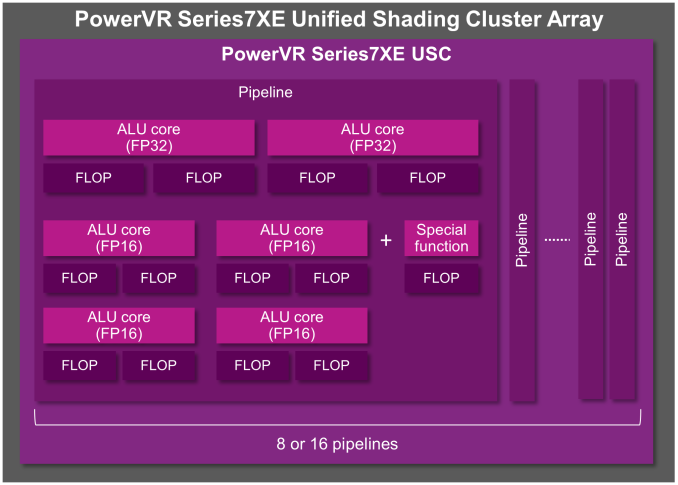
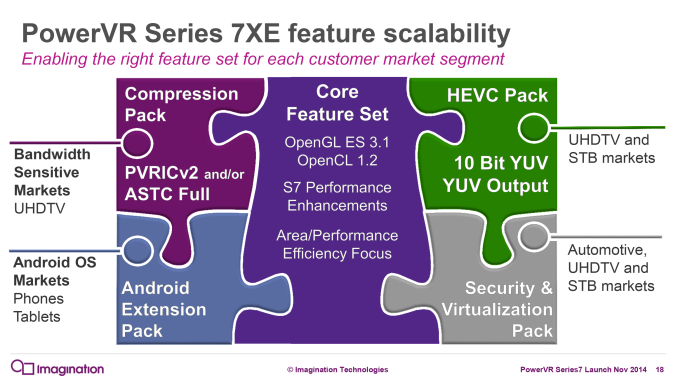









49 Comments
View All Comments
vFunct - Monday, November 10, 2014 - link
Has the 6XT been confirmed to be in the A8X?Wasn't it only announced earlier this year?
Ryan Smith - Monday, November 10, 2014 - link
Yes. A8 and A8X use Series6XT (the presence of ASTC is a dead giveaway).michael2k - Monday, November 10, 2014 - link
Isn't that crazy? It was only announced in January and the first shipping implementation was only 10 months later; that means the first working silicon was before August!milli - Tuesday, November 11, 2014 - link
Public announcement ≠ availability to licenseeslefty2 - Tuesday, November 11, 2014 - link
It's never been officially confirmed. They just assume it's 6XT. I wonder if Apple could get early access to features of the 7XT, seeing as they own 20% of the company.michael2k - Tuesday, November 11, 2014 - link
The presence of texture compression HW implies that it's a 6XT.lefty2 - Tuesday, November 11, 2014 - link
Yes, but Apple has a special relationship with with Imagination Technologies. Who's to say that it's not a "6XT delux", with some features from the 7 series?milli - Tuesday, November 11, 2014 - link
Ryan, is there no way to figure out the actual clock frequency of the GPU in A8X?LeptonX - Thursday, November 13, 2014 - link
People comparing GPU performance by the Gflops numbers are being unwise. It can be use only as an approximation of GPU performance with a huge margin or error that can be bigger than 100%.Radeon 4890 has more Gflops than GTX480 and which one is faster? GTX480 and it's faster by a factor of 2.
So don't be so quick to compare performance across architectures by one simple metric.